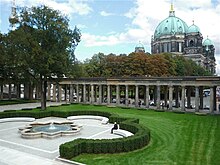Colonnaded courtyard
The colonnade on the Museum Island in Berlin district of Mitte is an enclosed on three sides by colonnades outdoor area at the entrance of the Old National Gallery . In a three-year construction period and at a total cost of around 20.7 million euros, the colonnades were repaired and the open space was redesigned with low planting, an expanded fountain and bronze sculptures from museum holdings. On June 6, 2010 the facility was opened to the public again. The colonnades behind the Alte Nationalgalerie will also be restored to their original state by 2022.
Open spaces
In addition to the existing and planned buildings, the Museum Island master plan also deals with the open spaces of different shapes and sizes between them. They should be accessible to the public and perceived as a cohesive ensemble. In 2001, the international competition "In-between spaces - design of public space on the Museum Island" was announced, and the first prize went to the architectural firm Levin Monsigny, Landschaftsarchitekten GmbH, Berlin. A uniform floor covering made of sand-colored natural stone is intended as a connecting element for all accessible areas.
The central open-air area on Museum Island is the colonnaded courtyard, surrounded by the buildings of the New Museum , the Pergamon Museum , the Old National Gallery and the colonnade walkways. The original design of the green area dates from 1880, planned by the Prussian horticultural master Eduard Neide (1818–1883), a student of Peter Joseph Lenné . The floor plan and motifs of the historical design have been taken up in the current version and - in close coordination with representatives of the preservation of monuments - carefully modernized. Different types of boxwood in graduated green tones and in a geometric arrangement form the main elements of the low vegetation areas. Immediately in front of the National Gallery is the renewed fountain system, framed by stone benches, a half-height hedge and three-quarters of the lawn.
Colonnades
King Friedrich Wilhelm IV of Prussia wanted the Spree island to be a "sanctuary for art and science". He had expressly suggested colonnades as a connecting architectural motif. On the basis of a design by Friedrich August Stüler from 1841, the colonnades in front of the south and east facade of the New Museum and on Bodestrasse were built in a first section between 1853 and 1860. According to the Stüler draft updated by Heinrich Strack and Georg Erbkam , the colonnades on the banks of the Spree and behind the Alte Nationalgalerie were built between 1876 and 1878. Special features of the colonnade on the banks of the Spree are three small, temple-like pavilions with flat domed roofs, one at each end and one in the middle.
The colonnades on the east side of the Neues Museum had already been restored when the reconstructed house reopened in October 2009. By June 2010, the sections on Bodestrasse and the banks of the Spree were given their original appearance. Found original fragments such as rosettes and ceiling elements could be used. The James-Simon-Galerie , the new entrance building for the houses on Museum Island , has been under construction behind the Neues Museum, on Kupfergraben , since 2011 . The architect David Chipperfield uses the historical motif of the colonnades in several places, now in a modern interpretation.
Bronze sculpture Diana by Reinhold Felderhoff
Area west of the Alte Nationalgalerie (right) with the bronze sculpture The Sower by Constantin Meunier
Sculptures
The restoration of the colonnaded courtyard included the development of a sculpture program. Free-standing sculptures have also been shown here earlier. They had and still have the task of referring to the collection of the Nationalgalerie, that is to say to the art of the 19th century (in a not too narrow time frame). The new selection, however, has a wider range than has been the case before. Of the original sculptures, in different locations, there are highlights such as the Amazon by Louis Tuaillon (1895), the sower by Constantin Meunier (1890), the lion by the animal sculptor August Gaul (1904) and the bow-tensioner by Ferdinand Lepcke (1905). There were also typical Wilhelmine sculptors such as Reinhold Begas with Centaur and Nymphe (1886), but also Reinhold Felderhoff , who had made the step from historicism to modernity with his Diana (1910) . The list of the group Saved by Adolf Brütt (1887) is more aimed at controversial consideration . According to the curators ' intention, the maudlin-looking sculpture "rejuvenates the discourse on the role and design of late 19th century art [...] as well as documenting what was previously in the collection and what was previously perceived as conforming or creating taste". A separate pedestal is intended to alternately accommodate works by contemporary artists and thus create a connection to the present. A ceramic was later created from Erich Hösel's bronze sculpture Hun on Horseback . All newly erected sculptures could be restored and preserved with funds from the building budget. A care budget is provided for the regular surface treatment of the free sculptures.
literature
- Bernhard Maaz : “The Muse and Temple District. On the reopening of the colonnade courtyard on Museum Island. ” In: Museums-Journal No. 3, July – September 2010, pp. 8–10. ISSN 0933-0593 .
- Prussian Cultural Heritage Foundation, State Museums in Berlin: Museum Island Berlin: The Colonnade Courtyard . Press release from June 4, 2010.
Web links
Individual evidence
- ↑ https://www.smb.museum/nachrichten/detail/zurueck-zu-stueler-kolonnaden-der-museumsinsel-berlin- wird-wieder-in-ihren-originalstatus-versetzt /
- ↑ Press release, pp. 1, 3
- ↑ Gardens in front of the National Gallery on the website of the Senate Department for Urban Development and Environment Berlin . Retrieved May 27, 2016.
- ↑ Maaz, p. 10
Coordinates: 52 ° 31 ′ 13 " N , 13 ° 23 ′ 56.2" E






